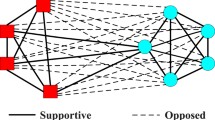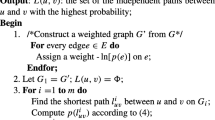Abstract
In this paper, we study information cascade in networks with positive and negative edges. The cascade depth is correlated with community structure of signed networks where communities are defined such that positive inter-community and negative intra-community links are minimized. The cascade is initialized from a number of nodes that are selected randomly. Finally, the number of nodes that have participated in the cascade is interpreted as cascade depth; the more the number of such nodes, the more the depth of the cascade. We investigate influence of community structure (i.e., percentage of inter-community positive and intra-community negative links) on the cascade depth. We find significant influence of community structure on cascade depth in both model and real networks. Our results show that the more the intra-community negative links (i.e., the worse the community structure), the more the cascade depth.
Similar content being viewed by others
References
Barabási, A.-L., “Network science,” Philosophical Transactions of the Royal Society A: Mathematical, Physical and Engineering Sciences, 371, 1987, 2013.
Barabási A.-L.: “Scale-free networks: a decade and beyond”. Science, 325(5939), 412–413 (2009)
Costa L.d.F, Oliveira Jr O.N, Travieso G, Rodrigues F.A, Villas Boas P.R, Antiqueira L, Viana M.P, Correa Rocha L.E: “Analyzing and modeling real-world phenomena with complex networks: a survey of applications,”. Advances in Physics, 60(3), 329–412 (2011)
Król, D., “On Modelling Social Propagation Phenomenon,” in Intelligent Information and Database Systems, 8398, pp. 227–236, Springer International Publishing, http://dx.doi.org/10.1007/978-3-319-05458-2_24, 2014.
Leskovec J, Adamic L.A, Huberman B.A.: “The dynamics of viral marketing,”. ACM Transactions on the Web (TWEB), 1(1), 5 (2007)
Newman M. E, Park J: “Why social networks are different from other types of networks,”. Physical Review E, 68(3), 036122 (2003)
Girvan M, Newman M. E: “Community structure in social and biological networks,”. Proc. of the National Academy of Sciences, 99(12), 7821–7826 (2002)
Easley, D. and Kleinberg, J., Networks, crowds, and markets, 8, Cambridge Univ. Press, 2010.
Coupechoux, E. and Lelarge, M., “How clustering affects epidemics in random networks,” arXiv preprint arXiv:1202.4974, 2012.
Doreian P, Mrvar A: “Partitioning signed social networks,”. Social Networks, 31(1), 111 (2009)
Antal T, Krapivsky P. L, Redner S: “Social balance on networks: The dynamics of friendship and enmity,”. Physica D: Nonlinear Phenomena, 224(1), 130–136 (2006)
Cartwright D, Harary F: “Structural balance: a generalization of heider’s theory,”. Psychological review, 63(5), 277 (1956)
Fan P, Wang H, Li P, Li W, Jiang Z: “Analysis of opinion spreading in homogeneous networks with signed relationships,”. Journal of Statistical Mechanics: Theory and Experiment, 2012(08), P08003 (2012)
Kostka, J., Oswald. Y. A. and Wattenhofer, R., “Word of mouth: Rumor dissemination in social networks,” in Structural Information and Communication Complexity, pp. 185–196, Springer, 2008.
Chen, W., Collins, A., Cummings, R., Ke, T., Liu, Z., Rincon, D., Sun, X., Wang, Y., Wei, W. and Yuan, Y., “Influence maximization in social networks when negative opinions may emerge and propagate,” in SDM, pp. 379–390, 2011.
Li, Y., Chen, W., Wang, Y. and Zhang, Z.-L., “Influence diffusion dynamics and influence maximization in social networks with friend and foe relationships,” in Proc. of the sixth ACM international conference on Web search and data mining, pp. 657–666, ACM, 2013.
Newman M.E.: “Modularity and community structure in networks,”. Proc. of the National Academy of Sciences 103, 23, pp. 8577–582, 2006.
Babaei M, Ghassemieh H, Jalili M: “Cascading failure tolerance of modular small-world networks,”. Circuits and Systems II: Express Briefs, IEEE Transactions on, 58(8), 527–531 (2011)
Jalili, M., “Synchronizability of complex networks with community structure,” International Journal of Modern Physics C, 23, 04, 2012.
Huang L, Park K, Lai Y.-C, Yang L, Yang K: “Abnormal synchronization in complex clustered networks,”. Physical review letters, 97(16), 164101 (2006)
Javari, A. and Jalili, M., “Cluster-based collaborative filtering for sign prediction in social networks with positive and negative links,” ACM Transaction on Intelligent Systems and Technology, 2013.
Erdos P, Rényi A: “On the evolution of random graphs,”. Publ. Math. Inst. Hungar. Acad. Sci, 5, 17–61 (1960)
Author information
Authors and Affiliations
Corresponding author
About this article
Cite this article
Shafaei, M., Jalili, M. Community Structure and Information Cascade in Signed Networks. New Gener. Comput. 32, 257–269 (2014). https://doi.org/10.1007/s00354-014-0404-7
Received:
Revised:
Published:
Issue Date:
DOI: https://doi.org/10.1007/s00354-014-0404-7




